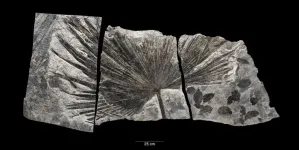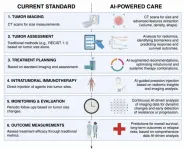(Press-News.org) Sometimes all it takes is a little push.
That is the conclusion of a recently published study in which doctors used a handheld ultrasound device to nudge patients’ kidney-stone fragments.
As many as 50% of patients who have kidney stones removed surgically still have small fragments remaining in the kidneys afterward. Of those patients, about 25% find themselves returning for another operation within five years to remove the now-larger fragments.
UW Medicine researchers found, however, that patients who underwent the stone-moving ultrasound procedure had a 70% lower risk of such a recurrence. The Journal of Urology published the findings in August.
“I think the main takeaways of this study are removing fragments reduces relapse and using a noninvasive, hand-held ultrasound device to help clear these kidney stone fragments,” said UW Medicine urologist Dr. Jonathan Harper, the study’s senior author.
The multisite, randomized and controlled trial was conducted from May 2015 to April 2024. Almost all of the 82 participants were from the UW Medicine or the VA Puget Sound health systems. All had stone fragments that had persisted in their kidneys for months, and their ureters were free of stones and fragments.
In the study, 40 underwent ultrasound treatment to encourage fragments to clear from the kidneys, while 42 control-group members received no such treatment.
With patients awake in a clinic office setting, doctors used a wand that generated ultrasonic pulses through the skin to move the fragments closer to the ureter, where they could be naturally expelled, sometimes with the next urination, Harper noted.
Harper and his co-lead author on the paper, urologist Dr. Mathew Sorensen, have worked on this technology and treatment for 15 years. They also use this technology, called burst wave lithotripsy, to blast larger stones into smaller pieces; those successes were published in 2022.
The pushing and breaking technologies are used with the same ultrasound platform.
Harper expressed hope that both clinical uses of the technology would become commonplace. A company, SonoMotion, is commercializing the technology, which was developed at the University of Washington, he added.
“I see a lot of potential in this It could become as common as getting your teeth cleaned. If you have a couple of small stones which could cause future problems, you make an office appointment and in 30 minutes you’re done.
“This could really revolutionize kidney stone treatment,” Harper said.
This study was supported by a grant (P01 DK043881) from the National Institute of Diabetes and Digestive and Kidney Diseases, part of the U.S. National Institutes of Health, and by resources from the Veterans Affairs Puget Sound Health Care System.
END
Pushing kidney-stone fragments reduces stones’ recurrence
Using ultrasound to reposition the smaller grains significantly lowers patients’ returns to the operating room, a study finds.
2024-09-19
ELSE PRESS RELEASES FROM THIS DATE:
Sweet success: genomic insights into the wax apple's flavor and fertility
2024-09-19
A recent study has successfully decoded the autotetraploid genome of the wax apple, uncovering its genetic evolution and key factors driving fruit diversity. The research highlights the fruit’s rich antioxidant profile, with promising implications for human health and breeding strategies aimed at enhancing nutritional value.
Wax apple (Syzygium samarangense), known for its crisp texture, rose-like aroma, and health benefits, faces breeding challenges due to its complex genetic diversity and limited genomic data. These obstacles have hindered efforts to improve key fruit qualities such as size and sugar ...
New study charts how Earth’s global temperature has drastically changed over the past 485 million years, driven by carbon dioxide
2024-09-19
A new study co-led by the Smithsonian and the University of Arizona offers the most detailed glimpse yet of how Earth’s surface temperature has changed over the past 485 million years. In a paper published today, Sept. 19, in the journal Science, a team of researchers, including paleobiologists Scott Wing and Brian Huber from the Smithsonian’s National Museum of Natural History, produce a curve of global mean surface temperature (GMST) across deep time—the Earth’s ancient past stretching over many millions of years. ...
Scientists say we have enough evidence to agree global action on microplastics
2024-09-19
Science has provided more than sufficient evidence to inform a collective and global approach to tackle the continued spread of plastic pollution, according to a new report.
Writing in the journal Science, an international group of experts say the need for worldwide action to tackle all forms of plastic and microplastic debris has never been more pressing.
It is clear that existing national legislation alone is insufficient to address the challenge, they say, and the United Nations’ Plastic Pollution Treaty ...
485 million-year temperature record of Earth reveals Phanerozoic climate variability
2024-09-19
Estimating past global temperature is important for understanding the history of life on Earth and for predicting future climate. Now, a new reconstruction of Earth’s temperature history over the past 485 million years – based on a method that combines diverse physical proxy data with climate model predictions – reveals a much wider range of climate variability across the Phanerozoic eon than previously understood. The findings highlight atmospheric carbon dioxide (CO2) as the dominant factor controlling climate variability throughout this period, offering new ...
Atmospheric blocking slows ocean-driven glacier melt in Greenland
2024-09-19
Cooling in the subsurface waters beneath Greenland’s Nioghalvfjerdsfjorden Glacier (79NG) from 2018 to 2021 was driven by European atmospheric blocking, which forced changes in the large-scale ocean circulation of the Nordic seas, researchers report, slowing glacial melt, despite ongoing global warming trends. The findings highlight the importance of regional atmospheric dynamics in influencing glacier stability. Understanding these dynamics is key to predicting the future of glaciers like ...
Study: Over nearly half a billion years, Earth’s global temperature has changed drastically, driven by carbon dioxide
2024-09-19
Published in the journal Science, the study presents a curve of global mean surface temperature that reveals Earth's temperature has varied more than previously thought over much of the Phanerozoic Eon a period of geologic time when life diversified, populated land and endured multiple mass extinctions. The curve also confirms Earth's temperature is strongly correlated to the amount of carbon dioxide in the atmosphere.
The start of the Phanerozoic Eon 540 million years ago is marked by the Cambrian ...
Clinical trial could move the needle in traumatic brain injury
2024-09-19
FOR IMMEDIATE RELEASE
Subscribe to UCSF News
Department of Defense-funded study aims to end a decades-long impasse in treatment development.
Traumatic brain injury (TBI) results in close to 70,000 deaths in the United States every year, and it is the cause of long-term physical, cognitive and mental disability in 5 million Americans. But despite three decades of work, treatments are sorely lacking.
Now, an innovative drug development trial will be available in emergency departments of 18 level 1 trauma sites nationwide. It is launched by UC San Francisco and the Transforming Research and Clinical Knowledge in Traumatic ...
AI model can reveal the structures of crystalline materials
2024-09-19
For more than 100 years, scientists have been using X-ray crystallography to determine the structure of crystalline materials such as metals, rocks, and ceramics.
This technique works best when the crystal is intact, but in many cases, scientists have only a powdered version of the material, which contains random fragments of the crystal. This makes it more challenging to piece together the overall structure.
MIT chemists have now come up with a new generative AI model that can make it much easier to determine the structures of these powdered crystals. The prediction model could help researchers characterize ...
MD Anderson Research Highlights for September 19, 2024
2024-09-19
HOUSTON ― The University of Texas MD Anderson Cancer Center’s Research Highlights showcases the latest breakthroughs in cancer care, research and prevention. These advances are made possible through seamless collaboration between MD Anderson’s world-leading clinicians and scientists, bringing discoveries from the lab to the clinic and back.
Genetic factors underscore disparities in colorectal cancer survival
Patients with colorectal cancer have varied overall survival, but it remains unclear how the frequency of certain gene mutations among different racial and ethnic groups influences outcomes. To investigate, researchers led by John Paul Shen, M.D., and ...
The role of artificial intelligence in advancing intratumoral immunotherapy
2024-09-19
“We explore how integrating these technologies could revolutionize personalized oncology.”
BUFFALO, NY- September 19, 2024 – A new editorial was published in Oncotarget's Volume 15 on September 17, 2024, entitled, “The emerging role of AI in enhancing intratumoral immunotherapy care.”
As highlighted in the abstract of this editorial, the emergence of immunotherapy (IO), and more recently, intratumoral IO, offers a novel approach to cancer treatment. This method enhances immune responses, allows for combination therapies, and helps reduce systemic adverse events. These techniques aim to ...
LAST 30 PRESS RELEASES:
Tracing the quick synthesis of an industrially important catalyst
New software sheds light on cancer’s hidden genetic networks
UT Health San Antonio awarded $3 million in CPRIT grants to bolster cancer research and prevention efforts in South Texas
Third symposium spotlights global challenge of new contaminants in China’s fight against pollution
From straw to soil harmony: International team reveals how biochar supercharges carbon-smart farming
Myeloma: How AI is redrawing the map of cancer care
Manhattan E. Charurat, Ph.D., MHS invested as the Homer and Martha Gudelsky Distinguished Professor in Medicine at the University of Maryland School of Medicine
Insilico Medicine’s Pharma.AI Q4 Winter Launch Recap: Revolutionizing drug discovery with cutting-edge AI innovations, accelerating the path to pharmaceutical superintelligence
Nanoplastics have diet-dependent impacts on digestive system health
Brain neuron death occurs throughout life and increases with age, a natural human protein drug may halt neuron death in Alzheimer’s disease
SPIE and CLP announce the recipients of the 2025 Advanced Photonics Young Innovator Award
Lessons from the Caldor Fire’s Christmas Valley ‘Miracle’
Ant societies rose by trading individual protection for collective power
Research reveals how ancient viral DNA shapes early embryonic development
A molecular gatekeeper that controls protein synthesis
New ‘cloaking device’ concept to shield sensitive tech from magnetic fields
Researchers show impact of mountain building and climate change on alpine biodiversity
Study models the transition from Neanderthals to modern humans in Europe
University of Phoenix College of Doctoral Studies releases white paper on AI-driven skilling to reduce burnout and restore worker autonomy
AIs fail at the game of visual “telephone”
The levers for a sustainable food system
Potential changes in US homelessness by ending federal support for housing first programs
Vulnerability of large language models to prompt injection when providing medical advice
Researchers develop new system for high-energy-density, long-life, multi-electron transfer bromine-based flow batteries
Ending federal support for housing first programs could increase U.S. homelessness by 5% in one year, new JAMA study finds
New research uncovers molecular ‘safety switch’ shielding cancers from immune attack
Bacteria resisting viral infection can still sink carbon to ocean floor
Younger biological age may increase depression risk in older women during COVID-19
Bharat Innovates 2026 National Basecamp Showcases India’s Most Promising Deep-Tech Ventures
Here’s what determines whether your income level rises or falls
[Press-News.org] Pushing kidney-stone fragments reduces stones’ recurrenceUsing ultrasound to reposition the smaller grains significantly lowers patients’ returns to the operating room, a study finds.



